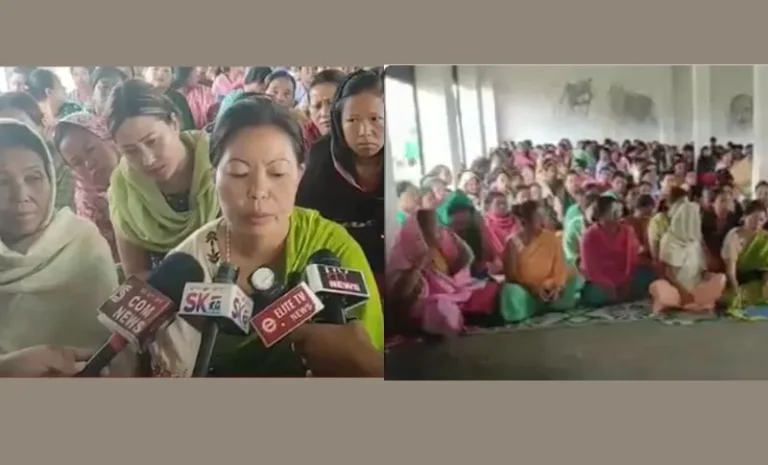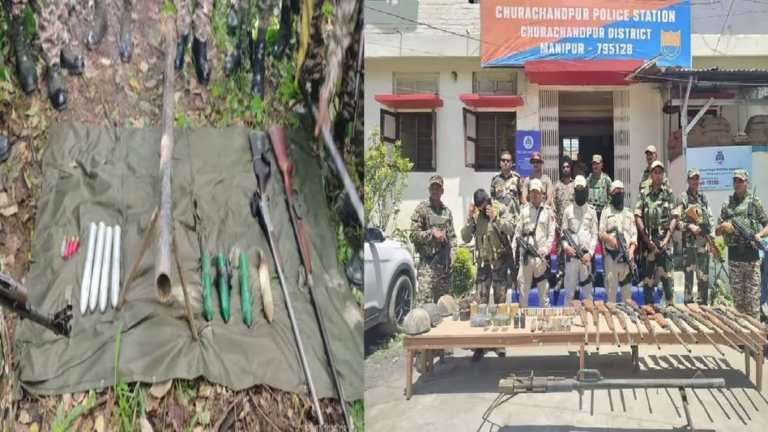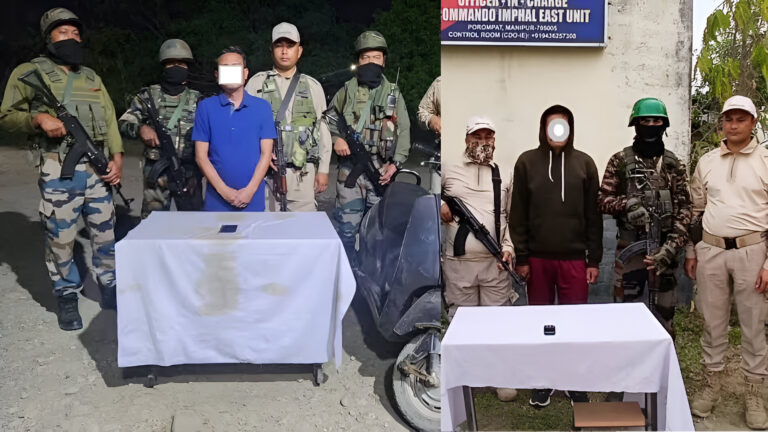Manipur Security Forces Arrest Suspect with Cash, Drugs, and Ammunition in Churachandpur: A Closer Look at the Operation
Summary
In a decisive crackdown on illegal activities, Manipur security forces arrested a suspect in Churachandpur found in possession of a large sum of cash, various drugs, and ammunition. This operation underscores the relentless efforts of law enforcement to dismantle criminal networks, secure public safety, and restore confidence in the region. By utilizing advanced surveillance and intelligence techniques, authorities have taken a significant step toward curbing organized crime and ensuring a safer community.
Detailed Article
Introduction
Have you ever wondered what happens behind the scenes when law enforcement takes on criminal enterprises? Recently in Churachandpur, Manipur, a bold operation by security forces led to the arrest of a suspect carrying not only a substantial amount of cash but also drugs and ammunition. This isn’t just another news headline—it’s a powerful reminder of the risks and challenges faced by security agencies in their daily fight against organized crime. In this article, we’ll walk through the details of the arrest, explore the broader implications of such operations, and discuss what this means for the local community and law enforcement practices.
Background of the Case
Before diving into the specifics of the arrest, let’s set the stage. Churachandpur, a district known for its vibrant culture and strategic location in Manipur, has unfortunately also been a hotspot for criminal activities over the years. The region’s complex socio-political dynamics, coupled with its proximity to international borders, have made it a fertile ground for illicit trade. Whether it’s drug trafficking, arms smuggling, or money laundering, criminal networks often exploit these vulnerabilities to operate with relative impunity.
For many local residents, the presence of such criminal elements creates an atmosphere of uncertainty and fear. Families worry about safety, businesses struggle to maintain legitimacy, and the overall trust in public institutions can take a hit. The arrest of a suspect found with cash, drugs, and ammunition is thus not just a law enforcement success; it’s a statement against the encroaching tide of crime that threatens the fabric of society.
The Arrest Operation: Step by Step
Imagine a scenario where every minute detail is crucial. That’s exactly how law enforcement officials approached this operation in Churachandpur. The arrest was the culmination of months of meticulous planning, intelligence gathering, and on-ground coordination. Here’s a step-by-step breakdown of how the operation unfolded:
- Intelligence Gathering:
The operation began with extensive surveillance. Officers monitored communications and movements in the area, piecing together clues that hinted at the presence of illicit activities. Local informants and community tips played a vital role in narrowing down the suspect’s location. - Pre-Operation Planning:
Once the intelligence was deemed reliable, a detailed operation plan was formulated. This included setting up a perimeter, ensuring that every exit route was monitored, and preparing for any potential resistance. It’s a bit like planning a chess game—every move had to be anticipated to avoid any counterattack. - Deployment of Technology:
Modern technology was the silent partner in this operation. Drones and high-resolution cameras scouted the area from above, while real-time communication networks ensured that all teams remained coordinated. This blend of high-tech tools and traditional policing methods increased the chances of a successful arrest. - Execution of the Raid:
At the designated time, security forces moved in swiftly. The suspect, caught off-guard, was apprehended without incident. The officers secured the scene, confiscating not only the cash and drugs but also the ammunition—a clear indication of the suspect’s involvement in potentially dangerous criminal networks. - Post-Arrest Procedures:
After the arrest, the suspect was taken into custody for further interrogation. Forensic teams began collecting evidence, including digital data and physical items, which will be crucial in building a strong case against any criminal organization he might be linked to.
This comprehensive operation highlights the importance of coordination, technology, and community cooperation in modern law enforcement. It’s not just about catching a suspect—it’s about dismantling a network and sending a clear message that crime will not be tolerated.
Investigative Techniques and Modern Policing
You might be curious about how law enforcement agencies today can pull off such complex operations. The answer lies in a strategic mix of traditional investigative techniques and modern technology. In Churachandpur, the integration of surveillance drones, satellite imagery, and digital data analysis was instrumental in piecing together the suspect’s movements and connections.
Think of it as having a high-tech magnifying glass that not only zooms in on minute details but also connects dots that were once thought to be unrelated. This high level of integration ensures that law enforcement remains one step ahead of criminals who are always evolving their tactics. It’s the digital age’s answer to age-old problems—using modern tools to tackle traditional crimes.
The Role of Community Cooperation
No law enforcement operation exists in a vacuum. Local communities are often the first line of defense against criminal activities. In Churachandpur, the community’s role was indispensable. Informants and residents who tipped off the authorities helped shape the operation’s success.
Imagine living in a neighborhood where everyone is on the lookout, ready to support the authorities. That sense of communal vigilance can be a game-changer, especially in regions where criminal networks try to operate under the radar. By fostering strong ties with local communities, law enforcement not only improves its operational effectiveness but also builds trust—a critical component in long-term public safety.
Implications for Public Safety and Trust
When a well-known region like Churachandpur experiences such a bold operation, the implications for public safety and community trust are significant. For many, the arrest is a reassurance that the security forces are committed to protecting the community, no matter how deep-rooted the criminal networks might be.
However, this success also raises questions about the underlying causes that allow such networks to flourish. Why do some areas become hotbeds for crime? Often, it’s a combination of socio-economic challenges, inadequate local governance, and historical neglect. Addressing these issues requires more than just arrests—it demands a comprehensive strategy that includes community development, improved infrastructure, and better economic opportunities.
Economic Impact of Criminal Activities
Criminal networks don’t just pose a threat to physical safety—they also have a profound impact on the local economy. In areas like Churachandpur, where illicit activities such as drug trafficking and arms smuggling are prevalent, the economic repercussions can be severe. Money that should be fueling legitimate businesses often ends up in the hands of criminals, leading to a cycle of corruption and underdevelopment.
The successful arrest in Churachandpur can help disrupt this cycle. By cutting off a major channel of illicit revenue, authorities not only dismantle criminal operations but also pave the way for economic revitalization. It’s similar to clearing a blockage in a river—the free flow of resources can then nourish the surrounding areas, promoting growth and stability.
Environmental and Social Considerations
While the focus is often on the criminal aspects of such operations, it’s important not to overlook the environmental and social dimensions. Regions plagued by criminal activities frequently suffer from neglect in other areas too—public services, environmental conservation, and social welfare can all take a hit. When law enforcement makes a significant arrest, it often has a ripple effect, leading to renewed government attention and investment in these areas.
For example, with the criminal element curtailed, local governments might redirect resources to improve infrastructure, educational facilities, and healthcare services. In a way, a successful operation like this can serve as a catalyst for broader social improvements. It’s like removing a thorn from your foot—suddenly, everything else can begin to heal.
Challenges Faced During the Operation
It’s easy to applaud a successful arrest without understanding the hurdles that had to be overcome. The operation in Churachandpur was not without its challenges. The rugged terrain, unpredictable weather, and the ever-present threat of armed resistance all added layers of complexity to the mission.
Officers had to maintain a delicate balance between assertiveness and caution. Too much force could have led to collateral damage or even loss of life, while too little might have allowed the suspect to escape. The meticulous planning and execution underscore the professionalism and bravery of the security forces. They navigated these challenges with the precision of a well-oiled machine, ensuring that the operation not only met its objectives but also set a standard for future interventions.
Interagency Collaboration and Coordination
Another fascinating aspect of this operation is the level of interagency collaboration involved. In today’s world, no single agency can tackle complex criminal networks alone. The Churachandpur operation saw the coordinated efforts of multiple law enforcement units, intelligence agencies, and forensic teams. Each played a specific role, contributing to the overall success of the mission.
Interagency collaboration brings together diverse expertise and resources, creating a synergy that enhances operational effectiveness. It’s like assembling a sports team where every player brings a unique skill set to the field. When coordinated properly, such teamwork can achieve extraordinary results—even in the face of formidable challenges.
Legal Ramifications and Ongoing Investigations
The arrest of a suspect with cash, drugs, and ammunition is not the end of the story—it’s just the beginning of a complex legal process. The evidence gathered during the operation will be critical in building a case against the suspect, and potentially, against any larger criminal network he might be part of.
Law enforcement agencies now face the task of piecing together the financial trails, communication records, and physical evidence that connect the dots. The legal proceedings that follow will likely be rigorous, aiming to ensure that justice is served and that the deterrent effect of such operations is reinforced. For the community, this means a continued commitment from the judicial system to uphold the rule of law and bring criminals to account.
Broader Implications for Regional Security
This high-profile arrest sends ripples far beyond the borders of Churachandpur. In regions like Manipur, where security challenges are multifaceted and ever-evolving, such operations highlight the need for constant vigilance and adaptation. The success of this operation may serve as a model for other districts grappling with similar issues, prompting a reevaluation of strategies and resource allocation across the board.
From a broader perspective, the arrest reinforces the message that criminal networks, no matter how deeply entrenched, can be dismantled through coordinated efforts and technological innovation. It’s a reminder that the fight against crime is ongoing—a battle that requires continuous improvement in tactics, policy, and community engagement.
The Human Element: Stories Behind the Arrest
Behind every operation, there are real people—both on the side of law enforcement and among the affected communities. The officers involved in the Churachandpur arrest risked their lives to ensure that criminals do not get away with activities that threaten public safety. Their dedication is a testament to the spirit of service and the sacrifices made daily to protect society.
On the other side, there are the communities that live with the consequences of criminal activities. For many, seeing a decisive operation like this instills hope. It’s a sign that their concerns are being taken seriously, that the authorities are committed to ensuring a safer future. These human stories—of courage, resilience, and the desire for a better tomorrow—are what truly bring depth to what might otherwise be seen as just another news report.
Preventive Measures and Future Strategies
Looking ahead, the success of this operation opens the door to new preventive measures and strategies to combat organized crime. Law enforcement agencies are likely to invest further in advanced surveillance technology, strengthen interagency communication channels, and enhance training programs to ensure that officers are equipped to handle similar situations in the future.
Community outreach programs, too, will play a pivotal role. By engaging local residents, providing platforms for anonymous tips, and building trust through transparency, authorities can create an environment where criminal activities are less likely to flourish. It’s about turning the tide—shifting from reactive measures to proactive strategies that address the root causes of crime.
Lessons Learned and the Road to Rehabilitation
Every major operation leaves behind valuable lessons. The Churachandpur arrest highlights several key takeaways. First, the importance of combining technology with traditional policing methods cannot be overstated. Second, community cooperation is indispensable in maintaining long-term security. And finally, the necessity of interagency collaboration is evident—no single entity can tackle these challenges alone.
For the suspect and others involved, the legal process ahead is also an opportunity for rehabilitation and reform. While punishment is essential, it’s equally important to address the socio-economic factors that push individuals toward criminal activities. Initiatives that offer education, job opportunities, and counseling can help steer lives away from a path of crime.
Conclusion
In wrapping up our comprehensive look at the Churachandpur operation, it’s clear that this arrest is more than a law enforcement victory—it’s a microcosm of the ongoing struggle against organized crime in Manipur and beyond. The seizure of cash, drugs, and ammunition represents a significant blow to criminal networks and sends a powerful message that no one is above the law.
This operation exemplifies how modern technology, community cooperation, and interagency collaboration can come together to tackle even the most challenging criminal enterprises. As we move forward, the lessons learned here will not only inform future operations but also serve as a rallying cry for a safer, more secure society.
The journey toward eradicating organized crime is a long one, filled with obstacles and challenges. Yet, each successful operation brings us one step closer to a future where communities can thrive free from the shadow of criminality. The dedication of Manipur’s security forces, coupled with the resilience of local communities, shows that together, we can overcome even the most entrenched issues.
Let this arrest in Churachandpur be a beacon of hope—a reminder that when vigilance meets technology and community spirit, no criminal enterprise can remain hidden forever. It’s a call to action for all stakeholders to work hand in hand, building a future where justice, safety, and progress go hand in hand.
Frequently Asked Questions (FAQs)
Q1: What led to the arrest of the suspect in Churachandpur?
A1: The arrest was the result of thorough intelligence gathering, advanced surveillance, and local community tips that pointed to the suspect’s involvement in illicit activities, including possession of cash, drugs, and ammunition.
Q2: How did technology aid in the operation?
A2: Modern tools like drones, satellite imagery, and data analytics played a critical role in identifying the suspect’s location and monitoring the operation in real time, ensuring a swift and efficient arrest.
Q3: What impact does this arrest have on the local community?
A3: The successful operation boosts public confidence in law enforcement, disrupts criminal networks, and paves the way for further community development initiatives, although it may also prompt discussions on alternative livelihood support.
Q4: What challenges did law enforcement face during this operation?
A4: The operation encountered challenges such as rugged terrain, the need for precise coordination, and the constant threat of armed resistance. Overcoming these required meticulous planning and interagency collaboration.
Q5: What future measures are being considered to prevent similar criminal activities?
A5: Authorities plan to invest further in advanced surveillance, strengthen community engagement, and enhance interagency cooperation and training programs to proactively counter organized crime.





